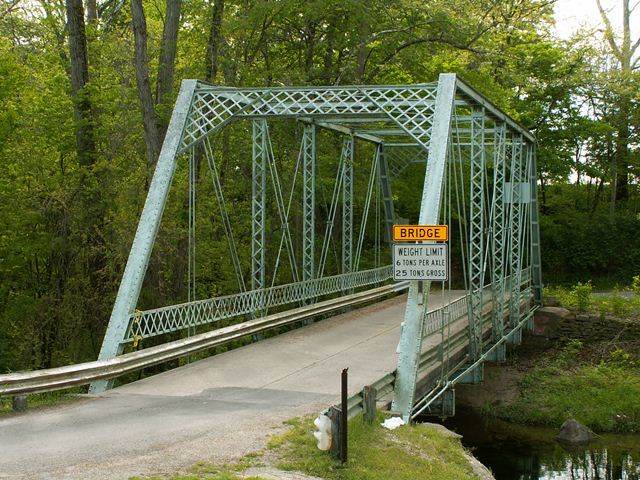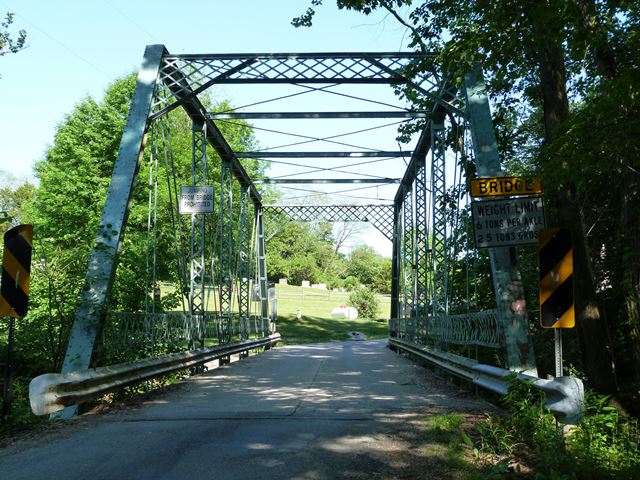We Recommend:
Bach Steel - Experts at historic truss bridge restoration.
BridgeHunter.com Phase 1 is released to the public! - Visit Now
Owens Road Bridge

Primary Photographer(s): Nathan Holth
Bridge Documented: May 7, 2006 and June 6, 2014
Rural: Miami County, Ohio: United States
By Builder/Contractor: Smith Bridge Company of Toledo, Ohio
1913
84.0 Feet (25.6 Meters)
86.0 Feet (26.2 Meters)
15.7 Feet (4.79 Meters)
1 Main Span(s)
5533260

View Information About HSR Ratings
Bridge Documentation
View Archived National Bridge Inventory Report - Has Additional Details and Evaluation

The construction date of this bridge is unknown, but is assumed to date to ca. 1885. The National Bridge Inventory lists a 1913 construction date with a 1958 rehabilitation date. The 1913 date is incorrect, because although no plaque remains, this bridge clearly displays the distinctive details of a bridge built by the Smith Bridge Company of Toledo, Ohio in the neighborhood of 1885. The 1913 date may be an indication that in that year this truss bridge was relocated from elsewhere and reused here in its current location on Owens Road.
There are two details that are very unique to Smith Bridge Company through truss bridges that are found on this bridge. First, the "feet" of this bridge, where the bearing and the bottom chord connection to the end post is located has a very distinctive design. The highly unusual design of this bridge "shoe" allows the entire end post to function like a rocker bearing. Another unusual detail at this location is that the bottom chord is not connected to the end post with a pin connection. Instead, a threaded rod with nut type connection is present.
The second distinctive detail that associates this bridge with the Smith Bridge Company is that at the base of the portal bracing knees, resting inside the channel of the end post is a decorative cast iron spindle that provides a pleasing termination to the portal bracing.
A third less unique detail, but also usually found with bridges built by the Smith Bridge Company is the overall design of the portal bracing. The top of the portal bracing sits lower than on most truss bridges built by other companies. Specifically, the top portion of the portal bracing lines up more or less with the bottom of the top chord rather that with the top of the top chord. Finally the shape of the portal bracing, somewhat like an A-frame with the top of the "A" cut off and the entirety filled with lattice is the standard shape that the Smith Bridge Company usually used.
Finally, even less unique when compared against other bridge companies, but definitely details preferred by the Smith Bridge Company is that the overhead struts lack any v-lacing or lattice, and the overhead lateral bracing includes turnbuckles allowing for the adjustment of these members.
When looking at other documented Smith Bridge Company through truss bridges from the 1880s, it is found that those dating to ca. 1883 usually had built-up triangular shaped "fishbelly style" floor beams that ended in decorative cast iron blocks. In contrast, later examples from as soon as a couple years later dating to ca. 1885 instead have built-up beams that are shaped in a more standard i-beam shape. Since the Owens Road Bridge displays the i-beam shaped floor beams, a ca. 1885 construction date for this bridge seems appropriate.
Given the above strong evidence above that this is a ca. 1885 Smith Bridge Company bridge, it is somewhat amusing to read the findings of Ohio's most recent major update to the Historic Bridge Inventory. The hired consultant apparently looked at this bridge with their eyes closed. They jumped on the 1913 construction date, and assumed it was correct (a big mistake considering how many errors can be found in the National Bridge Inventory) and failed to associate a builder with the bridge. They even stated that the bridge has "no distinctive details" suggesting they never even noticed the unusual bridge shoe. This bad evaluation actually has serious ramifications however. As a result of this poorly conducted evaluation in the Historic Bridge Inventory, this bridge was condemned as Ineligible for Listing in the National Register of Historic Places. Given the age of this bridge and its distinctive bridge shoe detail that illustrates the creative designs of a noteworthy Ohio bridge builder, this bridge should be Eligible for Listing in the National Register of Historic Places. As currently evaluated, this bridge is not protected from harm or destruction by federally bridge funding programs.
Other Smith Bridge Company bridges very similar to this bridge include the Morseville Bridge and the Hamilton Road Bridge. The 1883 Hamilton Road Bridge is one of the earlier examples and has the fishbelly floor beams. The 1885 Morseville Bridge has floor beams very similar to the Owens Road Bridge.
Information and Findings From Ohio's Historic Bridge InventorySetting/Context The bridge carries a 2 lane road over a stream in a sparsely developed, rural setting. Physical Description The 1 span, 86'-long, pin-connected Pratt thru truss bridge is traditionally composed of built-up compression members and eyebar tension members. U-shaped hangers at the lower panel points supported the built-up floorbeams. The bridge has lattice portal bracing. Summary of Significance The 1913 pin-connected Pratt thru truss bridge is later example of a common type/design and has no distinctive details or features. The builder is not documented by available county records. The not eligible
recommendation of the prior inventory remains appropriate. Bridge Considered Historic By Survey: No |
![]()
Photo Galleries and Videos: Owens Road Bridge
2014 Bridge Photo-Documentation
Original / Full Size PhotosA collection of overview and detail photos. This gallery offers photos in the highest available resolution and file size in a touch-friendly popup viewer.
Alternatively, Browse Without Using Viewer
![]()
2014 Bridge Photo-Documentation
Mobile Optimized PhotosA collection of overview and detail photos. This gallery features data-friendly, fast-loading photos in a touch-friendly popup viewer.
Alternatively, Browse Without Using Viewer
![]()
2006 Bridge Photo-Documentation
Original / Full Size PhotosA collection of overview and detail photos. This gallery offers photos in the highest available resolution and file size in a touch-friendly popup viewer.
Alternatively, Browse Without Using Viewer
![]()
2006 Bridge Photo-Documentation
Mobile Optimized PhotosA collection of overview and detail photos. This gallery features data-friendly, fast-loading photos in a touch-friendly popup viewer.
Alternatively, Browse Without Using Viewer
![]()
Maps and Links: Owens Road Bridge
Coordinates (Latitude, Longitude):
Search For Additional Bridge Listings:
Bridgehunter.com: View listed bridges within 0.5 miles (0.8 kilometers) of this bridge.
Bridgehunter.com: View listed bridges within 10 miles (16 kilometers) of this bridge.
Additional Maps:
Google Streetview (If Available)
GeoHack (Additional Links and Coordinates)
Apple Maps (Via DuckDuckGo Search)
Apple Maps (Apple devices only)
Android: Open Location In Your Map or GPS App
Flickr Gallery (Find Nearby Photos)
Wikimedia Commons (Find Nearby Photos)
Directions Via Sygic For Android
Directions Via Sygic For iOS and Android Dolphin Browser
USGS National Map (United States Only)
Historical USGS Topo Maps (United States Only)
Historic Aerials (United States Only)
CalTopo Maps (United States Only)


